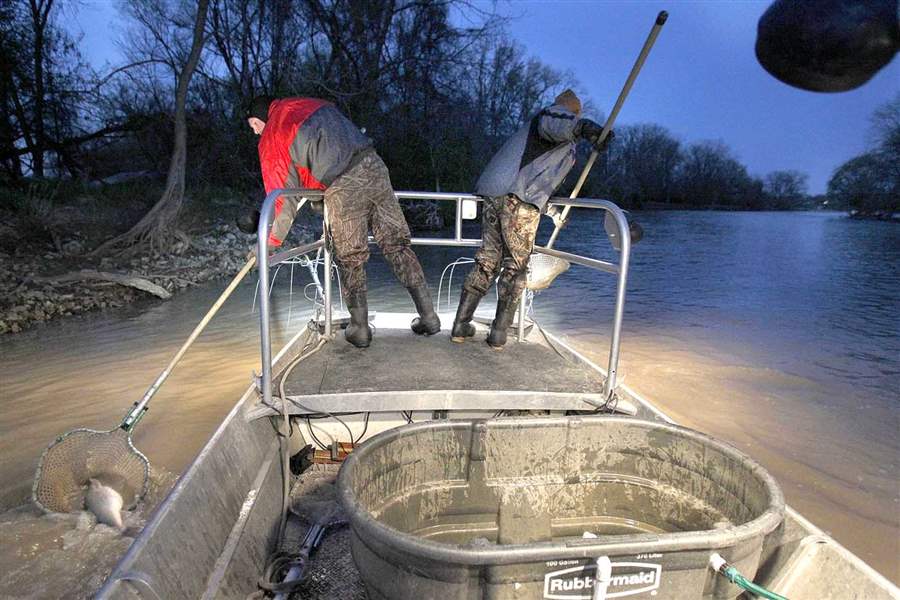
COMMENTARY
Research: Hatchery work not harming river’s walleye
Northwest Ohio anglers had raised concern
4/21/2017
Ohio Division of Wildlife biologist Eric Weimer, left, and Steven Gratz of the Ohio State Research Association use a mild electrical shock to stun spawning walleye in the Maumee River.
THE BLADE
Buy This Image
ST. MARYS, Ohio — Anglers in the state’s upland reservoirs will catch thousands of adult saugeye in the coming years, likely unaware those feisty hybrids started their journey on a chilly spring night in 2017 along the Maumee River.
Those saugeye will be born at the state hatchery here this month, grown from the eggs of Lake Erie walleye that had ventured up the Maumee on their annual spawning run. Working at night several times this spring, biologists from the Ohio Division of Wildlife captured female walleye, stripped the eggs from the fish, and released the walleye back into the river.
At the St. Marys Hatchery, millions of eggs removed from Maumee River walleye are mixed with the milt from sauger captured on the Ohio River to produce the saugeye, a hybrid that has flourished in the state’s reservoirs. These fish grow fast, are cooperative biters, and put up a good fight.
RELATED: Blade Fishing Report, 4/21
Some northwest Ohio anglers have raised concerns about removing eggs from Maumee River spawners and insist it carries a negative impact on the overall walleye population in Lake Erie. They also question the shocking method and conclude it harms or kills the fish.
If we look closely at the shocking and egg extraction process, examine the spawning method for walleye, and take in the depth and breadth of the walleye resource in the lake, we can conclude this is not the case.
First, the shocking technique that stuns the fish so they can be captured does not result in fish being killed, biologists contend. Long wands send a mild electrical current into the water, momentarily stunning the fish. About 150 to 200 fish were collected, stripped of their eggs, then released back into the river this spring.
“They are basically anesthetized,” said Mike Wilkerson, the fish management supervisor for the Division of Wildlife’s northwest Ohio district. “Most of the fish just swim away before we can net them. We have been using this method for about 30-plus years, and there is no evidence that it harms the fish in any way. There has been no indication that it has killed fish.”
Now the numbers, as compiled by biologists Matt Faust and Eric Weimer from the Division of Wildlife’s fisheries operation in Sandusky, and Travis Hartman, the Lake Erie Program Administrator for the division. They also utilized the work of researcher Jeremy Pritt from the University of Toledo.
The best estimate puts the number of female walleye in the river each spring at around 200,000, and those females average about 225,000 eggs per fish, putting the total egg production in the river at about 45 billion.
The shocking and egg removal work took place on just four or five nights this spring, and the goal was to collect 350 quarts of walleye eggs. If that goal is reached, at around 145,000 eggs per quart, that comes out to a maximum of 50,750,000 eggs that could be removed and sent to the hatchery. Percentage-wise, that is about 0.11 percent of the total walleye eggs in the river during the spawning run.
“In reality and based on recent hatchery estimates, over the past six years they have collected from 11 to 17 million eggs per year, far short of the 50 million in that estimate,” Hartman said. “Most years, we are collecting well less than 0.1 percent of the potential number of eggs in the river.”
More studies show that anglers fishing the spawning run are removing few eggs from the river, since 90 to 95 percent of the legal catch during the run involves male walleye.
“Fishing during the spring spawning season really has no effect on the population of walleye in the lake,” Wilkerson said. “When you are looking at the millions of fish in Lake Erie, the harvest number from the spawning run is miniscule, and very few females are taken out.”
Even in a worst-case scenario where every harvested female was considered to be pre-spawn (and many are post-spawn), the impact of anglers barely registers a blip on the walleye population radar. In 2016, the female walleye harvest during the spawning run was 2,622 fish, and if they were all egg laden pre-spawn fish, that would account for about 660 million eggs, which is 1.47 percent of the total walleye eggs in the river.
Wilkerson said the majority of Lake Erie’s walleye spawn on the reefs in the lake, with just around 400,000 to 500,000 estimated to enter the rivers.
“That is a pretty small number, out of the tens of millions of fish in the lake, and there is plenty of evidence to show that the adult population in the lake is not related to the number of eggs in the river,” he said.
Wilkerson said the biologists also remove about 150 walleye from the Maumee each spring to test for the possible presence of Viral Hemorrhagic Septicemia (VHS), a deadly virus that has been responsible for large fish kills in Lake Huron, Lake St. Clair, and the St. Lawrence River. The livers are removed from these fish and sent to the U.S. Fish & Wildlife Service for analysis. The fillets go to a food pantry in Sandusky to feed the needy.
No live fish are removed from the Maumee River to be stocked elsewhere, Wilkerson said, and he added no saugeye, or walleye in the years when those fish are produced in the hatchery, are stocked in Lake Erie. Each year, the Division of Wildlife stocks more than 7,000,000 saugeye in some 70 reservoirs in the state.
Contact Blade outdoors editor Matt Markey at: mmarkey@theblade.com or 419-724-6068.